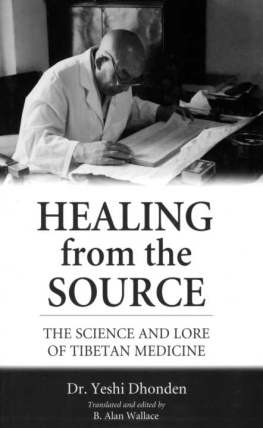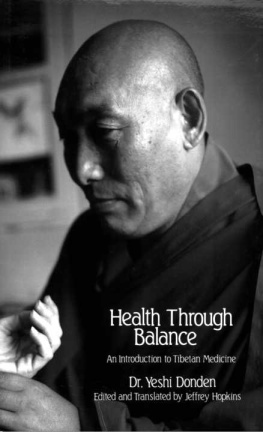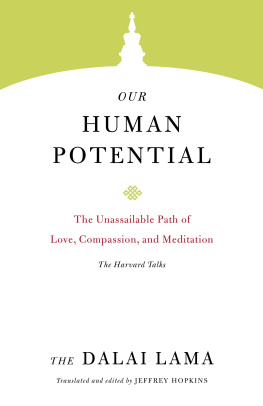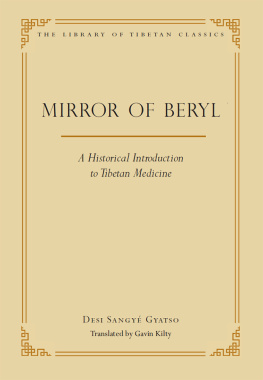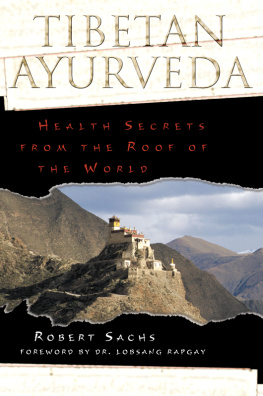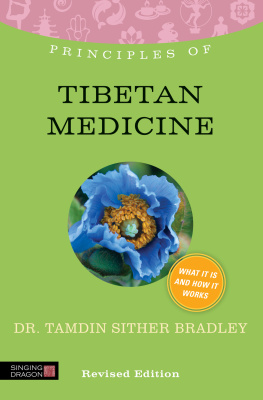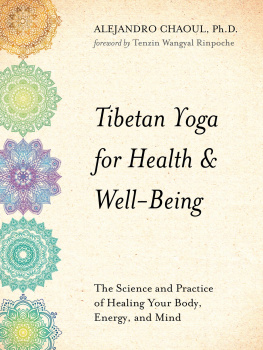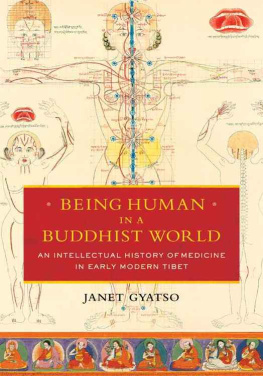Healing from the Source
The Science and Lore of Tibetan Medicine
Healing from the Source
The Science and Lore of Tibetan Medicine
Dr. Yeshi Dhonden
Translated and edited by
B. Alan Wallace



Contents
of Humoral Disorders
Author's Acknowledgments
I would first like to thank His Holiness the Fourteenth Dalai Lama. It is through his dedication to bring a greater awareness of the culture and tradition of Tibet to the world that Tibetan Buddhism and Tibetan Medicine now flourish.
I would also like to thank my teacher, Venerable Dr. Khyenrab Norbu (1883-1962), personal physician to His Holiness the Thirteenth and Fourteenth Dalai Lama (in Tibet), who founded and developed the MenTsee-Khang, the Tibetan Medical and Astrology Institute in Tibet.
Special thanks to all those who helped with this book: Alan Wallace for his great skill and commitment to make these ancient teachings available to the modern West, and to those who transcribed and helped edit these lectures, including Dr.Tenzin Dhakpa, Dr. Marsha Woolf, and others.
I would like to thank my staff in India at our clinic: Dr. Lobsang Tenzin, who has been with me for thirty-five years and has acted as my personal attendant, chief pharmacist and director of the clinic. He has not only been invaluable in his service in India, but has accompanied me to America for many years. Together we conducted research at the University of Virginia in 1980, and we are now currently conducting a formal, FDAapproved clinical trial at University of California, San Francisco.
Other staff members to whom I would like to express my thanks include: Venerable Lundup Yeshi, Chomphel Kalsang, Lobsang Tsundu, and Ms. Kalsang Dolma, who serves as my interpreter in both India and the U.S. in our clinical trials.
Finally, I would like to express my gratitude to Dr. Marsha Woolf, who for a number of years has acted as my coordinator in the U.S., liaison and collaborator in the development of our clinical trials, and clinical director.
Dr. Yeshi Dhonden
Translator's Preface
Dr. Yeshi Dhonden was born in Lhasa, the capital city of Tibet, in 1929. His schooling began at the age of six, and two years later he took the novice vows of a Buddhist monk. He began his preliminary studies of Tibetan medicine when he was nine, and at the age of thirteen he was formally admitted to the Astro-Medical Institute in Lhasa. There he studied for five years under the master physician Khyenrab Norbu. His internship lasted from the age of eighteen to twenty-two. For the next ten years, he practiced medicine as an itinerant doctor, traveling widely throughout Tibet. Then in 1959, the year of the Tibetan uprising against the Chinese Communist invasion of their homeland, Dr. Dhonden fled to India, along with 100,000 other Tibetan refugees. In 1961, he became the personal physician of His Holiness the Dalai Lama, a post which he filled for eighteen years. In the following year he re-established the Men-Tsee-Khang, Tibetan Medical and Astrological Institute in Dharamsala, India, where he remained until 1969, when he returned to private practice. The author of Health Through Balance, the foremost introduction to Tibetan medicine in English, Dr. Dhonden is among the most renowned of Tibetan physicians living today.
In the editing of these lectures, many people volunteered their time and expertise. I would like to thank all those friends in the San Francisco Bay Area who transcribed Dr. Dhonden's lectures, especially Lynn Quirolo for her unflagging, selfless service. I am also indebted to Dr. Marsha Woolf, David Molk, Loran Davidson, and Kara V. Frame for their help in preparing this manuscript; and I wish to express my special thanks to Dr. Tenzin Dhakpa of the Tibetan Medical Institute in Dharamsala, India, for his careful reading of the entire manuscript and his many invaluable corrections and comments. Finally, I would like to thank the Balm Foundation for their generous support for the editing of this work.
Introduction
A Brief History of Tibetan Medicine
What we now call Tibetan medicine was first introduced into Tibet during the reign of that same king, when two doctors, Biji Gadje and his female companion Bihla Gadzey, came to Tibet from India and practiced in the court of King Thothori Nyentsen. In Bodhgaya, Tara, the feminine embodiment of enlightened compassion, had previously appeared to them in a vision and told them they should go to Tibet to practice and teach medicine there. For many generations thereafter, this medical system was transmitted from teacher to disciple solely as an oral lineage, without any textual basis.
King Thothori Nyentsen gave one of his daughters, Yikyi Rolcha, as a wife to Biji Gadje, who practiced medicine in Tibet for twenty-four years. From their union a son was born named Dunggi Thorchok, so called for
King Trisong Detsen was the most important of all the Tibetan kings in terms of bringing Buddhism from India to Tibet in the late eighth century, and it was during his reign that the first Buddhist monastery of Samye was founded. During this era, a great number of Sanskrit manuscripts were translated into Tibetan at Samye. These works set forth the whole of the Buddhist tradition, from the basic teachings of Buddhist monastic discipline, many of the discourses of the Buddha recorded in the sutras, numerous tantras revealing the esoteric teachings of the Vajrayana, and many other fields of knowledge from classical Indian Buddhist culture. This marked the first great flourishing of Buddhism in Tibet.
Moslems from Turkey invaded India in the eleventh century, burnt books on Buddhism and its medical tradition and destroyed Buddhist monasteries. Much of the Buddhist medical literature that had been translated into Tibetan was lost forever in the original Sanskrit. With the recent resurgence of interest in Indian Buddhist literature, Indian and Tibetan scholars in universities in Varanasi and elsewhere in India have been working together to try to reconstruct Sanskrit versions of Indian texts from the precise Tibetan translations.
As for the origins of these teachings, Buddha Sakyamuni attained enlightenment at the age of thirty-five in Bodhgaya in northern India. In his first discourse to five close disciples he taught the Four Noble Truths, setting forth the framework of his entire teachings. Over the following years he gave many discourses, ranging from the basic teachings on ethical discipline to the most esoteric teachings of the Vajrayana. There are many references to medicine among the sutras and tantras that he taught.
Countless eons ago, the Buddha Vaidyaraja appeared on earth and gave many teachings, and he was the first to teach The Four Tantras. Buddha Sakyamuni preserved these teachings from the Buddha Vaidyaraja, and he taught them himself in Varanasi. In his text Vbadsdkofa the Indian Buddhist pandit Vasubandhu refers to the eight branches of medicine taught in The Four Medical Tantras taught by Buddha Sakyamuni when he assumed the form of the Buddha Vaidyaraja in the emanated realm of Sudarsana. In this visionary environment the Buddha, as Vaidyaraja, emanated the form of Vairocana from the crown of his head, symbolizing the primordial wisdom of the absolute nature of reality. From his throat he emanated the Buddha Amitabha, symbolizing the primordial wisdom of discernment. From his heart he emanated the Buddha Aksobhya, symbolizing mirrorlike primordial wisdom. From his navel he emanated Ratnasambhava, symbolizing the primordial wisdom of equality. And from his genital region he emanated Amoghasiddhi, symbolizing the primordial wisdom of accomplishment.

